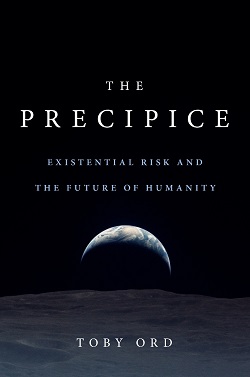
Risk management is the identification, evaluation, and prioritization of risks followed by coordinated and economical application of resources to minimize, monitor, and control the probability or impact of unfortunate events or to maximize the realization of opportunities.
The precautionary principle is a broad epistemological, philosophical and legal approach to innovations with potential for causing harm when extensive scientific knowledge on the matter is lacking. It emphasizes caution, pausing and review before leaping into new innovations that may prove disastrous. Critics argue that it is vague, self-cancelling, unscientific and an obstacle to progress.
In economics, a moral hazard is a situation where an economic actor has an incentive to increase its exposure to risk because it does not bear the full costs of that risk. For example, when a corporation is insured, it may take on higher risk knowing that its insurance will pay the associated costs. A moral hazard may occur where the actions of the risk-taking party change to the detriment of the cost-bearing party after a financial transaction has taken place.
Risk assessment determines possible mishaps, their likelihood and consequences, and the tolerances for such events. The results of this process may be expressed in a quantitative or qualitative fashion. Risk assessment is an inherent part of a broader risk management strategy to help reduce any potential risk-related consequences.

Safety is the state of being "safe", the condition of being protected from harm or other danger. Safety can also refer to the control of recognized hazards in order to achieve an acceptable level of risk.

Nick Bostrom is a philosopher known for his work on existential risk, the anthropic principle, human enhancement ethics, whole brain emulation, superintelligence risks, and the reversal test. He was the founding director of the now dissolved Future of Humanity Institute at the University of Oxford and is now Principal Researcher at the Macrostrategy Research Initiative.
A superintelligence is a hypothetical agent that possesses intelligence far surpassing that of the brightest and most gifted human minds. "Superintelligence" may also refer to a property of problem-solving systems whether or not these high-level intellectual competencies are embodied in agents that act in the world. A superintelligence may or may not be created by an intelligence explosion and associated with a technological singularity.
In criminal law, criminal negligence is an offence that involves a breach of an objective standard of behaviour expected of a defendant. It may be contrasted with strictly liable offences, which do not consider states of mind in determining criminal liability, or offenses that requires mens rea, a mental state of guilt.

Human extinction is the hypothetical end of the human species, either by population decline due to extraneous natural causes, such as an asteroid impact or large-scale volcanism, or via anthropogenic destruction (self-extinction), for example by sub-replacement fertility.

In tort law, a duty of care is a legal obligation that is imposed on an individual, requiring adherence to a standard of reasonable care to avoid careless acts that could foreseeably harm others, and lead to claim in negligence. It is the first element that must be established to proceed with an action in negligence. The claimant must be able to show a duty of care imposed by law that the defendant has breached. In turn, breaching a duty may subject an individual to liability. The duty of care may be imposed by operation of law between individuals who have no current direct relationship but eventually become related in some manner, as defined by common law.

Environmental hazards are those hazards that affect biomes or ecosystems. Well known examples include oil spills, water pollution, slash and burn deforestation, air pollution, ground fissures, and build-up of atmospheric carbon dioxide. Physical exposure to environmental hazards is usually involuntary
In criminal law and in the law of tort, recklessness may be defined as the state of mind where a person deliberately and unjustifiably pursues a course of action while consciously disregarding any risks flowing from such action. Recklessness is less culpable than malice, but is more blameworthy than carelessness.

The Future of Humanity Institute (FHI) was an interdisciplinary research centre at the University of Oxford investigating big-picture questions about humanity and its prospects. It was founded in 2005 as part of the Faculty of Philosophy and the Oxford Martin School. Its director was philosopher Nick Bostrom, and its research staff included futurist Anders Sandberg and Giving What We Can founder Toby Ord.
Under United States law, an element of a crime is one of a set of facts that must all be proven to convict a defendant of a crime. Before a court finds a defendant guilty of a criminal offense, the prosecution must present evidence that, even when opposed by any evidence the defense may choose, is credible and sufficient to prove beyond a reasonable doubt that the defendant committed each element of the particular crime charged. The component parts that make up any particular crime vary now depending on the crime.

A global catastrophic risk or a doomsday scenario is a hypothetical event that could damage human well-being on a global scale, even endangering or destroying modern civilization. An event that could cause human extinction or permanently and drastically curtail humanity's existence or potential is known as an "existential risk."

A hazard is a potential source of harm. Substances, events, or circumstances can constitute hazards when their nature would allow them, even just theoretically, to cause damage to health, life, property, or any other interest of value. The probability of that harm being realized in a specific incident, combined with the magnitude of potential harm, make up its risk, a term often used synonymously in colloquial speech.

In simple terms, risk is the possibility of something bad happening. Risk involves uncertainty about the effects/implications of an activity with respect to something that humans value, often focusing on negative, undesirable consequences. Many different definitions have been proposed. The international standard definition of risk for common understanding in different applications is "effect of uncertainty on objectives".
In computer security, a threat is a potential negative action or event facilitated by a vulnerability that results in an unwanted impact to a computer system or application.
Existential risk from artificial general intelligence is the idea that substantial progress in artificial general intelligence (AGI) could result in human extinction or an irreversible global catastrophe.

The Precipice: Existential Risk and the Future of Humanity is a 2020 non-fiction book by the Australian philosopher Toby Ord, a senior research fellow at the Future of Humanity Institute in Oxford. It argues that humanity faces unprecedented risks over the next few centuries and examines the moral significance of safeguarding humanity's future.










